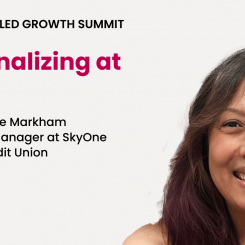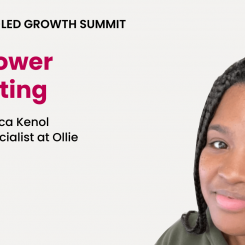If you’re a marketing leader in, say, a retail business, you might think that a customer loyalty program is the best way to build up a pool of repeat buyers.
It’s a smart move. Loyalty lets you build a fence around your top customers and keep them coming back with incentives. But if you’re looking to grow your business and turn your customers’ passion into revenue, then you should build a referral marketing program before you worry about loyalty.
While referral and loyalty work great in tandem, customers won’t start buying from you just because of a loyalty program. They overwhelmingly make buying decisions based on recommendations from friends. That’s exactly what a referral is, which is why referral marketing doesn’t just pull in more customers, but also more loyal customers as well.
So in the absence of either referral or loyalty, the formula is simple: Introduce referral early on, use it to build up a base of highly-engaged customers, and then bring in a loyalty program to further incentivize those customers to stick with you. You don’t need a points system to build a referral program that scales. Knowing that, let’s dive into the top three reasons to build referral first and loyalty second.
1. Referral Rewards Customers Immediately
Customer loyalty programs are powerful because they reward customers who stick around in a cost-effective way. The points systems motivate members to keep buying as they see themselves accumulating points and getting closer towards, and marketers can design these systems to ensure they’re never losing money on the prizes they give away.
But therein lies the problem as well. Loyalty programs don’t get immediate engagement with customers because it takes so long for customers to build up enough points for great rewards. Take Nordstrom’s loyalty program for instance. Lower-tier members have to spend $2000 just to get a $20 gift card.
Referral marketing increases engagement from the word “go”. When customers are excited about a brand, they want to share it with their friends. For instance, our internal research shows that 84% of customers recommend products to friends at least once a month and nearly 30% do so once a week or more.
Referral taps into that instinct. Customers can get rewards as soon as their friends convert instead of steadily working to accumulate points, which creates a positive feedback cycle and encourages them to keep referring. Plus, by gamifying your referral system and recognizing the most prolific advocates, you can tap into a similar dynamic as the loyalty points system and amplify the desire to refer again and again.
Here’s how your referral program can start rewarding customers ASAP:
- Everyday advocacy. From the get-go, promote the referral opportunity to everyone who interacts with your brand, and not just people who have bought from you.
- Double-sided rewards. Our research has shown that rewarding both advocates and new customers leads to more referrals, revenue, and new customers.
- Reward quickly. Give advocates and new customers their rewards as soon as the referral converts. The faster participants get rewards, the faster they refer again.
Each of those tactics leverages referral’s speed advantage and motivates your advocates to recruit more customers.
2. Referral Supercharges Customer Acquisition
Customer loyalty is great for nurturing your highly-engaged, repeat customers and giving them an incentive to keep buying from you. But it’s totally useless if you don’t have a big pool of potential loyalty members. You need to create a steady stream of new customers.
That’s where referral marketing comes to the rescue. It lets you tap into the customers you already have to supercharge acquisition and grow like crazy. Referred prospects convert at a 3-5x higher rate than average and are then 4x more likely to share a referral themselves.
The best way to maximize those increased conversion rates is to design referral to be totally seamless. Let people share, accept, and collect their rewards in as few clicks as possible to maximize the number of new customers. Consider:
- No accounts, please. Don’t force customers to create an account on your site to share or accept a referral. It’s an unnecessary extra step no one wants to complete.
- Simplify your codes. Give customers short, easy-to-remember referral codes. If customers have to fumble around with a long, awkward jumble of numbers and letters, many of them will just give up before converting.
- Referral on any device. Make it easy for customers to share and accept referrals on mobile via email, text, messaging apps—whatever platform is easiest for them.
Each of those small tactics makes referral easier, which means more customers through the funnel.
3. Referral Targets Customers Who Love Your Brand
Worldwide, airlines have 356 million members in their frequent flyer programs, and it makes perfect sense. Most airlines provide the same experience, so extra rewards like, say, hotel discounts can be enough to break the tie for customers. The problem is that the customer’s loyalty is totally dependent on that incentive, meaning they’ll bolt for a better offer.
But Virgin America breaks that mold. It’s the highest-rated airline in the U.S. because of its unique perks and commitment to customer experience. That brand is an essential part of its referral program. Customers who accept a Virgin referral do so because they’re excited about the superior service. If the company delivers, that customer will fly Virgin for life.
While loyalty brings in customers by offering rewards apart from the actual product, referral hooks customers by amplifying brand messaging. That creates a deeper connection between the company and the customer.
The data bears that out. Referred customers are 16% more likely to stick with your business and have a 20% higher lifetime value than the average customer. Better yet, when you eventually *do* create a customer loyalty program, those highly-engaged referred customers will want to join.
The key to tapping into this is to make it easy for advocates to invite the specific people they know will love your brand enough to become highly-satisfied customers. Consider these strategies:
- All contacts on deck. Let customers import and look through all of their email contacts for that perfect new customer.
- Messaging mediums. Make it easy for advocates to send referrals through any channel they want on mobile: texting, email, social media—anything.
- Make social sharing easier. If customers are sharing a referral via Facebook or Twitter, encourage them to tag the friends they think would be the most excited about your company.
Simple, convenient features like those can work wonders.
Referral Lays the Groundwork
Today’s consumers have nearly infinite choices, which means that acquiring and retaining them is harder than ever. A potent combination of referral marketing and customer loyalty both captures new customers and gives them a reason to stick around.
But customer loyalty will fall flat if there isn’t a base of engaged customers to draw from. Companies with neither should start with referral to create an immediate source of new customers, and then introduce loyalty later to keep them around. That’s the best way for the two programs to maximize one another’s results.




